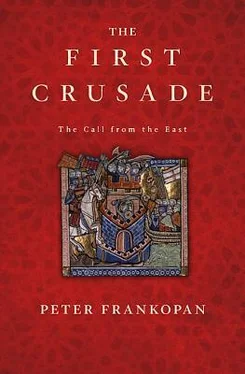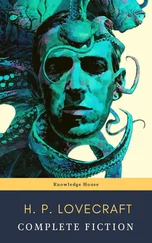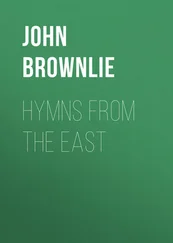There were other aspects of the expedition that needed careful thought. Preparations were made in Constantinople as to how best to police the vast number of westerners as they arrived in the east: ‘The emperor summoned certain leaders of the Roman forces and sent them to the area around Dyrrakhion and Avlona with instructions to receive the voyagers kindly and to supply them abundantly with provisions gathered from all along their route; they were to watch them carefully and shadow their movements, so that if they saw them making raids or running off to plunder the neighbouring districts, they could check them by light skirmishes. These officers were accompanied by interpreters who understood the Latin language; their duty was to quell any incipient trouble that might arise.’ 67
Steps were taken to ensure easy passage across imperial territory. When Godfrey of Bouillon reached the frontier, he was issued with a special licence to acquire provisions from markets which appear to have been closed to the local population. 68This meant that food was readily available along the way, a step designed to prevent a large armed force being dangerously antagonised by provisioning shortages and also to allow food prices to be fixed centrally. Price inflation would therefore be controlled, preventing local traders from exploiting supply imbalances.
Alexios also ordered that generous amounts of money be given to the westerners as they arrived in Byzantium. This was done in part to win the goodwill of men coming into contact with the empire for the first time. But, as one sharp commentator pointed out, it was also smart economics: all the funds paid out by the emperor found their way back into the imperial coffers, as the money was spent on goods sold by the emperor’s agents. 69
This pattern of closed markets and imperial largesse was reproduced across the Byzantine western provinces, along the two principal routes to Constantinople. When he reached the town of Naissos in the Balkans in the autumn of 1096, Godfrey was delighted to receive corn, barley, wine and oil, as well as many game animals as a personal gift from the emperor. A licence was again given to his men, allowing them to buy provisions and also to sell whatever they wished. Godfrey’s force spent several days there ‘in great plenty and enjoyment’. 70The efficiency of the provisioning put in place by Alexios is revealed by the fact that Bohemond was so well supplied when he crossed difficult terrain through Epirus, Macedonia and Thrace that his stocks of wine and corn actually increased. 71
A key issue that required thought was the route taken by the Crusaders. The principal leaders made their way to Constantinople with their various contingents under separate steam. Some, like Godfrey of Bouillon, passed through Germany and central Europe, making for Byzantium via the land route which took them through the Balkans and then on to the capital. Others, however, travelled the length of Italy, embarking on ships in Apulia before crossing over to Epirus and then following the Via Egnatia, the road linking Old and New Rome. Robert of Flanders, Hugh of Vermandois, Stephen of Blois and Robert of Normandy all took this route, as did Bohemond and the small contingent of Normans from southern Italy. Although there is little direct evidence to link the magnates’ choice of route to Alexios, the intervals at which these contingents travelled seem too convenient and perfect to be coincidental. The gaps between their arrival minimised the strain on Byzantium’s resources and infrastructure, and as such it is reasonable to assume they were deliberately co-ordinated.
One case in particular points to the emperor’s involvement in planning the first stages of the expedition and suggests that he was playing an active role even before the Crusaders reached the empire’s frontiers. As we have seen, Raymond of Toulouse was one of the first magnates that the Pope had turned to. His wealth, status and the support he had previously given to the papacy made him a powerful natural ally. The count had a difficult journey to Byzantium, travelling through Slavonia – ‘a forsaken land, both inaccessible and mountainous where for three weeks we saw neither wild beasts nor birds’, according to one man who accompanied him. This was hostile territory, where Raymond’s men were regularly attacked and killed. Thick fog, dense forests and rugged mountains made it difficult to protect the force as it made its way south. The count responded with reprisals against the local population, blinding some, cutting the feet off others and mutilating the faces of more to serve as a stern deterrent. 72So difficult was the journey that Raymond’s chaplain only made sense of the travails by concluding that God was using the strength and suffering of the Crusaders to inspire ‘brutish pagan men’ to turn from their sinfulness and thus be spared from doom. 73
In fact, the Count of Toulouse took this route for good reason: to bring to heel Constantine Bodin, the Serbian ruler whose attacks on Byzantium on the eve of the Crusade had done much to increase pressure on the emperor and whose contacts with the antipope had aggravated Urban.That so important a figure as Raymond passed through the remote coastal area of Zeta indicates how precisely the First Crusade had been planned in advance. The fact that Raymond went down the Dalmatian coast was a clear sign the emperor and the Pope had worked together. While the arrival of manpower was designed in the first instance to take Nicaea and to root out the Turks in western Asia Minor, Alexios was alert to other regions where he could also benefit. The Count of Toulouse, a man close to the Pope, was therefore chosen as a trusted figure who could take an unusual and difficult route so as to impress on Bodin the errors of his ways. Little wonder, then, that the latter became aggressive when he did so, setting his men to attack Raymond as an agent of the emperor and a threat to Serbian independence. 74Nevertheless, there was to be no further disruption on the empire’s north-western frontier for decades afterwards. It was an early indication that Alexios had much to gain from the expedition to Jerusalem.
In the second half of 1096, vast numbers of men were on the move, heading for Constantinople, the first stop on the way east. Estimates now suggest that as many as 80,000 may have taken part in the First Crusade. 75Never before had there been such a large, organised movement of people over such a long distance and over such a short period. This presented problems to the participants, who were drawn from many parts of western Europe. ‘Therefore since such a multitude came from all western countries,’ wrote Fulcher of Chartres, ‘little by little and day by day the army grew while on the march from a numberless host into a group of armies. You could see a countless number from many lands and of many languages.’ 76The same author later goes on to list the rich tapestry of people on the expedition: ‘Who ever heard of such a mixture of languages in one army? There were Franks, Flemings, Frisians, Gauls, Allobroges, Lotharingians, Alemanni, Bavarians, Normans, English, Scots, Aquitanians, Italians, Dacians, Apulians, Iberians, Bretons, Greeks and Armenians. If any Breton or Teuton wished to question me, I could neither reply nor understand.’ 77
The expedition promised to be a demonstration of Christian solidarity, a unique occasion where church schism, regional identity, secular and ecclesiastical squabbles counted for nothing. But this was above all a crowning moment in the collaboration between Rome and Constantinople and a great cause for optimism. The union of the churches seemed to be within grasp when the Council of Bari in 1098 and that of Rome the following year attempted to resolve those issues that had strained relations between east and west for decades. If things turned out well, with the help of the westerners Byzantium would finally make headway against the Turks in Asia Minor. And those taking part in the expedition were eager to reach the Holy City. There was great anticipation as the First Crusade got under way.
Читать дальше











